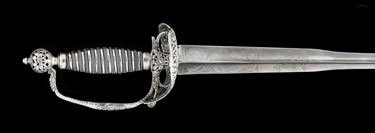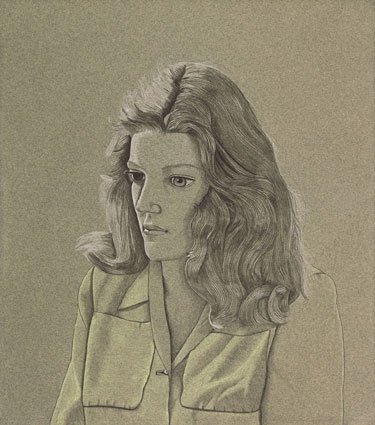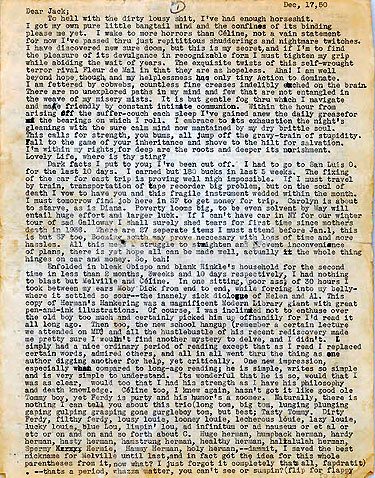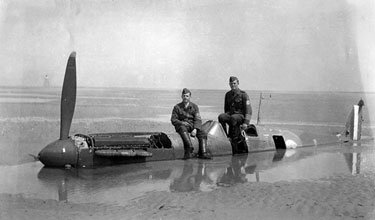Category Archive 'Christie’s'
30 Aug 2016


Christie’s Sale 12186
Important American Furniture, Silver, Outsider and Folk Art
20 September 2016, New York, Rockefeller Plaza
Lot 854
THE BENJAMIN FRANKLIN SILVER-HILTED SMALL SWORD
PROBABLY SPANISH, CIRCA 1760
Estimate USD 200,000 – USD 300,000
with tapering Colichemarde blade of hollow triangular section, etched at the forte with scrollwork, and engraved inscription (a 19th century addition) in French Epée que portait Benjamin Franklin dans les combats livrés en Amérique pour la cause de la Liberté. / Il la donna depuis à son ami P.J.G. Cabania (sic) [Sword worn by Benjamin Franklin in the battles fought in America in the cause of Liberty. / He then gave it to his friend P.J.G. Cabanis], silver hilt comprising symmetrical shell-guard, quillion-block, knuckle-guard and pommel (rear-quillion missing) pierced with scrollwork and stylised trophies, and grip bound with silver wire and ribbon; with brown leather scabbard with silver locket decorated en suite with the hilt and struck on the reverse with a silversmith’s mark, and later silver chape with iron finial; and later close-fitted velvet-lined leather-covered case with brass mounts
The sword: 33 ½ in. (85 cm.) blade; 40 3/8 in. (102.5 cm.) overall
The case: 42 5/8 in. (108.3 cm.) long
The locket (upper scabbard mount) bearing a silversmith’s mark of SS in a rectangle, determined to be that of Samuel Soumaine (1718-circa 1769) of Annapolis, Maryland and Philadelphia, Pennsylvania.
More here.
larger version here
20 Jun 2016

Lucien Freud, drawing of Pauline Tennant, 1945
Christie’s Sale 13100, Defining British Art, 30 June 2016, King Street, London, Estimate: £2,000,000 – £3,000,000 ($2,844,000 – $4,266,000).
24 May 2016


At Christie’s Books and Manuscripts Sale 12260, 16 June 2016, in New York, Neal Cassaday’s 40-page Lost Letter to Jack Kerouac, Lot 146, Estimated price: $400,000 — $600,000.
Considered ‘lost’ for 66 years, Neal Cassady’s visionary ‘Joan Anderson letter’ is a foundational document of the Beat era and the inspiration for Kerouac’s literary revolutions, beginning with On the Road.
Neal Cassady’s long-lost letter to Jack Kerouac, dated 17 December 1950, has permeated virtually every conversation about the Beat era. Referenced not only by Kerouac but by Allen Ginsberg, Laurence Ferlinghetti, Herbert Hunke, and a host of their contemporaries, Cassady’s fluid, incantatory, and deeply revealing prose influenced the entire generation of Beat writers.
The letter was written on a three-day Benzedrine high, Cassady later confessed. It contained, by Kerouac’s first calculation, at least 13,000 words and ran to 40 pages, offering a compelling, unaffected and discursive account of Cassady’s frenetic love life in 1946, particularly with Joan Anderson (whom he visited in a hospital after a failed suicide), and ‘Cherry Mary’, recounting an acrobatic escape through a bathroom window when they were surprised by Mary’s aunt. The uninhibited, non-literary narrative pointed the way to the free, truthful style to which Kerouac aspired.
Overwhelmed by what he read, Kerouac wrote ecstatically to Cassady on 27 December: ‘I thought it ranked among the best things ever written in America… it was almost as good as the unbelievably good ‘Notes from the Underground’ of Dostoevsky… You gather together all the best styles… of Joyce, Céline, Dosy… and utilize them in the muscular rush of your own narrative style & excitement. I say truly, no Dreiser, no Wolfe has come close to it; Melville was never truer.’
01 Apr 2016


Christies, New York, 13 April 2016, Sale 11898, Lot 36:
A MAGNIFICENT & IMPORTANT CASED PAIR OF FRENCH SILVER-MOUNTED RIFLED FLINTLOCK PISTOLS
BY NICOLAS-NOEL BOUTET, VERSAILLES, THE CASE DATED ‘1825’
With blued and gilt swamped octagonal barrels each cut with multi-groove rifling and decorated with gold-inlaid bands and finely engraved panels of foliage and Empire-style ornament, engraved and gilt breeches each struck with three maker’s marks, engraved and gilt tangs decorated en suite, silver fore-sights, blued flat bevelled locks each with roller, gold-lined rainproof priming-pan and fine gold-encrusted ornament involving foliage, a dragon and a wolf, the lower edge of each lock respectively signed ‘N.N. BOUTET A VERSAILLES’ and ‘MANUFACTURE ROYALE A VERSAILLES’ in gold, each with set trigger mounted on an engraved iron trigger-plate, exquisite silver mounts cast and chased with Classical ornament against a stippled gilt ground, comprising trigger-guards each with trophy of arms finial and winged deity with laurel wreath, rear ramrod pipes each with Medusa mask, pommels each with Hercules mask, and side-plates each depicting the mythical fight between the Centaurs and Lapiths at the wedding feast of Peirithous, original silver-mounted ramrods, and each with gold escutcheon mounted behind the barrel tang bearing the name ‘BOLIVAR’, in silver-bound close-fitted veneered case lined in green velvet, the lid with tooled and gilt red Morocco lining signed ‘MANUFACTURE ROYALE / à / VERSAILLES / 1825 / N.N. BOUTET / Le Dépôt de La Manuf.re a Paris. Rue Des Filles St. Thomas No.23’, the exterior with silver escutcheon signed ‘N.N. BOUTET A VERSAILLES’ with accessories including silver-gilt-mounted powder-flask with sprung nozzle and case-hardened bullet-mould, Paris silver marks for circa 1809-1818
Provenance
Gifted by General Gilbert Motier, Marquis de Lafayette, to Simón BolÃvar, El Libertador, in 1825
Gifted (before 1830) by Simón BolÃvar to Jose Ignacio Paris (d. 1848)
Enriqué Paris, son, by descent
By whom sold to Enriqué Grice (d. 1860), 7 July 1851
The collection of William Goodwin Renwick (1886-1971)
Sold Sotheby’s London, Highly Important Firearms from the collection of the late William Goodwin Renwick (European, Part III), 19 March 1973, lot 21
The collection of Clay P. Bedford (1903-1991)
A private Latin American collection
A private American collection
Estimate $1,500,000 – $2,500,000
16 Oct 2015

Lot 20, De Beers, a Brass and Diamond Hourglass Timer, containing 2000 diamonds weighing roughly 36 Carats, Christie’s “Elements of Style Auction,” Shanghai, “24 October 2015
Fortune reports that Communist China now has more billionaires than the United States does.
Even with concerns over its economy, China can now claim to have surpassed the U.S. in one wealth indicator: the number of billionaires within its borders.
A survey conducted by The Hurun Report says China now has 596 billionaires, surpassing the U.S. tally for the first time (the U.S. has 537 billionaires, according to the report). If 119 billionaires from Hong Kong, Taiwan, and Macao are added, Greater China owns 715 billionaires in the “Hurun Global Rich List.â€
Christie’s, as you see (above) now holds auctions of preposterously expensive timepieces in Shanghai.
03 Jun 2015

A ROMAN GOLD AND GARNET WINGED THUNDERBOLT PENDANT
CIRCA 1ST CENTURY A.D.
From Christie’s.
30 Apr 2015


German soldiers sitting on the wreckage of Spitfire P9374, May, 1940.
The Mirror:
One of the first Spitfires ever made has gone up for sale for a staggering £2.5 million after spending 40 years buried in sand at the French beach it crashed on.
The iconic Mark 1 plane was among the first built in March 1940 as Britain scrambled to ready itself for the epic battle that took place in the skies just a few months later.
But Spitfire P9374 never made it to the Battle of Britain as it crash-landed in May 1940.
The fighter plane was being piloted by Flight Officer Peter Cazenove over Dunkirk when it was hit by a single bullet from a German Dornier bomber.
Cazenove, an Old Etonian flying his first combat mission, had no choice but to bring it down on the wet sands at Calais.
Cazenove was captured by the Nazis and taken to the Stalag Luft III prisoner of war camp, famous for ‘The Great Escape’.
His plane became consumed by the sandy beach and there it remained for the next 40 years.
In 1980 the wreckage was discovered when part of it was spotted poking out from its sandy grave.
It was corroded and covered in barnacles but amazingly still in tact. The plane was dragged from the beach and taken to the Mus e de l’Air in Paris.
Eventually it was bought by American billionaire philanthropist Thomas Kaplan, who has had the plane meticulously restored to its original condition by a team of expert engineers.
Mr Kaplan, an Oxford-educated gold trader, owns both of the surviving Mk1 Spitfires.
He has now listed the plane Cazenove piloted for sale through London auctioneers Christies 75 years since the Battle of Britain with an estimate of £2.5 million.
He plans to donate the proceeds to the RAF Benevolent Fund and wildlife charity Panthera.
—————————————————-
Don’t miss the grand presentation, complete with videos, from Christie’s.

Flight Officer Peter Cazenove
27 Dec 2014

Christie’s bullshit is so totally audacious that the listener’s mind boggles at the notion that anyone with that kind of money would be stupid enough to buy it.
*And do note the spelling error!
Daily Paywall (not working today, but quoted by Fred Lapides) was appropriately skeptical.
Among the many records set at Christie’s astonishing $852.9m contemporary art sale in New York…, one has so far gone strangely unreported; the highest price ever paid for a urinal.
Robert Gober’s 1988 installation Three Urinals sold for $3.52m, which works out at just over $1m per urinal. They do not actually work – that is, they only take the proverbial in a figurative sense. But this is a good thing, for according to Christie’s their “smooth contours invite the viewer’s touchâ€, and hand sanitiser was not included in the price.
That a urinal by an artist you have probably never heard of is worth more than a masterpiece by one you have (a Gober urinal will buy you a fine Rubens) is down to the unique way in which the contemporary art world functions. There, the merit of works such as Gober’s is not judged in any traditional and objective artistic sense, but by value.
Expensive, say the experts, equals good. After all, Three Urinals is indistinguishable from three actual urinals except by virtue of its price, and several paragraphs of impenetrable art-speak in a catalogue. And if Gober’s urinals are worth $3.5m, then one of his sinks (he does a whole range of toilet ware) must also be worth millions.
In other words, we have collectively lost the ability to assess art for ourselves and on its own merits. Instead, we follow such indicators as fashion, price, and, in this case, hype. You may say it was ever thus. But the result today, when allied with an ever wealthier elite for whom buying contemporary art has become a form of conspicuous consumption, is an unprecedented art boom. Can it last?
Normally, speculative bubbles end when an underlying financial reality hits home. The subprime boom ended when homeowners stopped making repayments. But in the art world there are few such constraints. The only requirement is that works keep edging up in value.
Read the whole thing.

Robert Gober, Three Urinals, 1988. Sold for $3.52 million on 12 November 2014.
04 Apr 2012

Sphragistics, the study of heraldic and other seals, is of considerable interest historically and genealogically.
A very impressive collection of seals belonging to Michel Neugarten (can these possibly have belonged to the race car and film stunt driver?) will be sold by Christie’s, Sale 4889, at their South Kensington, London salesrooms on April 25th.
The collection seems to have some very interesting and luxurious 19th century examples, and a number of earlier Western European seals. Ecclesiastical specimens seem to be well represented in the collection.
Lots 501-665

18 Feb 2010

That Skull and Bones balloting box was not actually sold. Apparently, Christie’s withdrew it from the sale late last month, IvyGate reports, after receiving a mysterious “title claim.†The Russell Trust has plenty of lawyers.
——————————————
Hot Air (one of the most important conservative blogs) has been sold to Salem Communications. Congratulations and good luck.
——————————————

As part of the Carnival celebration, preceding the beginning of Lent, in the Spanish village of Laza, “Peliqueiros” or ancient tax collectors, are portrayed wearing warning cowbells and prepared to beat the villagers with sticks. 39 Carnival photos.
——————————————
Stratfor: Tradecraft in Dubai Assassination
3:14 video
08 Jan 2010


Christies will be selling at its New York sale 2287, titled Important American Furniture, Folk Art, Silver & Chinese Export, on January 22nd, lot 157, a Skull and Bones balloting box, along with a membership book dated 1872, the graduation year of the former owner, Edward T. Owen (1850 – 1931).
Owen, after Yale, studied at Gottingen and the University of Paris, and became in 1878 professor of French language and literature at the University of Wisconsin. He taught for one year (1886) at the University of California at Berkeley. Professor Owen was also a successful real estate investor and played a prominent role in creating the park system of Wisconsin’s capital, personally donating significant portions of the city’s parks and drives.
Professor Owen apparently, as a hobby, amassed a very important collection of “lithodoctra,” which he he left to the University of Wisconsin. I am particularly impressed myself, finding the word completely unknown to both Google and the Oxford English Dictionary. Litho is obviously “stone” and doctra “teaching, instruction.” But what on earth are lithodoctra?
Professor Owen’s Bones material includes 50 photographs of members of the Yale Senior Society, including future President William Howard Taft; Morrison Remick White, who later became Chief Justice, and William Maxwell Evarts, who went on to become US Secretary of State.
Yale Daily News
London Times
HuffPo recently linked a 4:49 video allegedly showing a courtyard behind the Society’s High Street tomb and investigating a crawlspace beneath the building.
23 Aug 2008


Kitagawa Utamaro (1753?-1806), Mono omou koi (Reflective Love),
from the series of five prints entitled Kasen koi no bu (Anthology of Poems: The Love Section), c. 1793-94
Estimated to sell for $1,000,000 – $1,500,000 at the Christie’s auction sale of Japanese & Korean art scheduled for September 18, 2008 at Rockefeller Center in New York.
Jeffrey Olson‘s excellent description reads (in part):
Her underrobe lies loose about her neck, as in a casual moment at the end of a day, and her eyes are unusually compressed to give the sense of the heavy-lidded stare of the daydreamer. Features or dress that might define personality or status or period are absent. Utamaro is using “delicious approximations” to decant the sensation from the scene.2
The visual glory of Reflective Love begins with the contrasts between the planes of color. The violet inner robe and matching silk hair tie are breathtaking. Purple, one of the most fugitive hues, tends to fade to grayish brown. The muted colors of the Reflective Love in the Musée Guimet prompted Richard Lane to remark on Utamaro’s subdued palette.3 Its cool tone conveys a somber mood, a brooding over something lost or never to be. The impression here—the vermilion lips and cuff lining, the velvet swirl of hair—is stirring (fig. 1). The underrobe is in a traditional tie-dyed dappled pattern (kanoko shibori moyo) that appears often in Japanese prints, usually on undergarments. Utamaro uses it to stage intimate settings, as here. The middle robe has the trellis design of plain-weave robes from crossing warp and weft threads. The fabric of the outerrobe represents crepe treated with wax resist so that the clusters of plovers and dots, symbolizing clouds or waves, appear white against the dyed grey.
The pink mica ground is exceedingly rare. …
Shibui Kiyoshi (1899-1992), a collector and scholar of Japanese woodcuts, offered that the pink mica of Reflective Love represents the light of a lantern. Extending his implication that the background is not simply a costly gloss, but is intended to establish mood by suggesting the time of day, one might equally see the pink as crepuscular. To take another step, consider the poem by Fujiwara Teika (1162-1241) using the same pivot, “vacant reverie” (omoi), to which Emperor Komyo linked his poem in the sequence mentioned above:
kino kyo Yesterday, today–
kumo no hatate nino matter how I gaze in vacant reverie
nagamu tote toward the cloud tips
mi mo senu hito no tinted in the evening, how can I know
omoi ya wa shiru the feelings of one I cannot see?
(Fuga waka shu X: 954)
2:19 recording.
Your are browsing
the Archives of Never Yet Melted in the 'Christie’s' Category.
/div>

Feeds
|

















